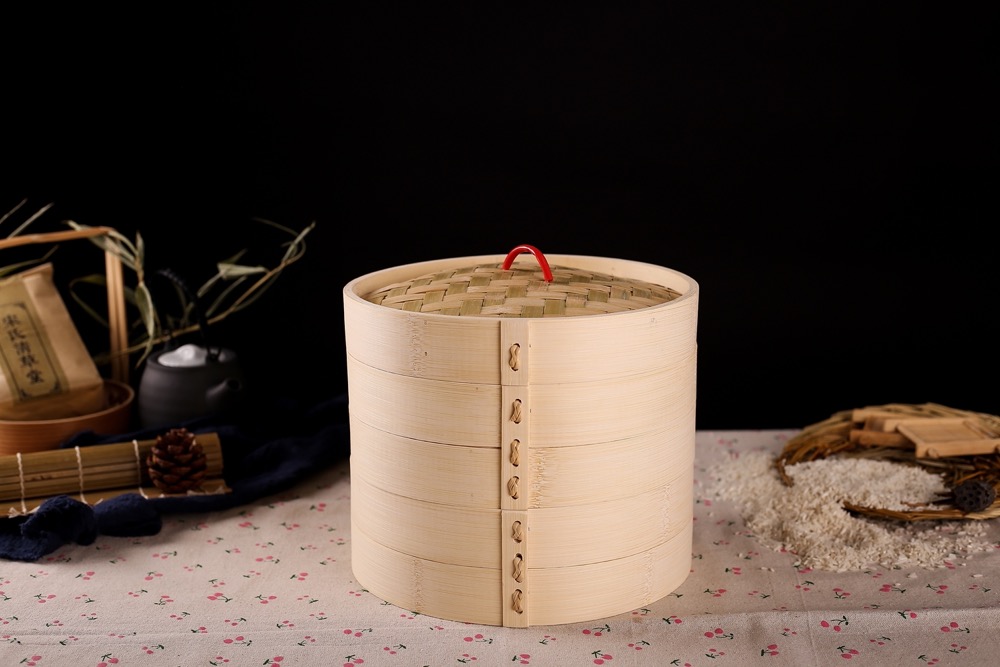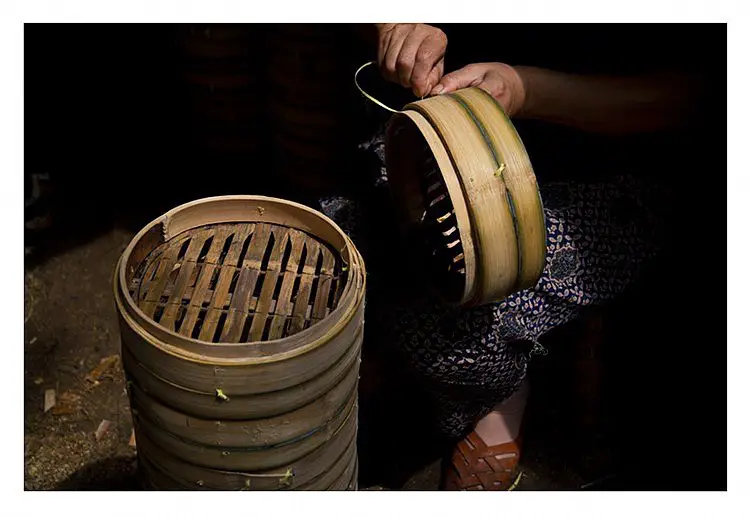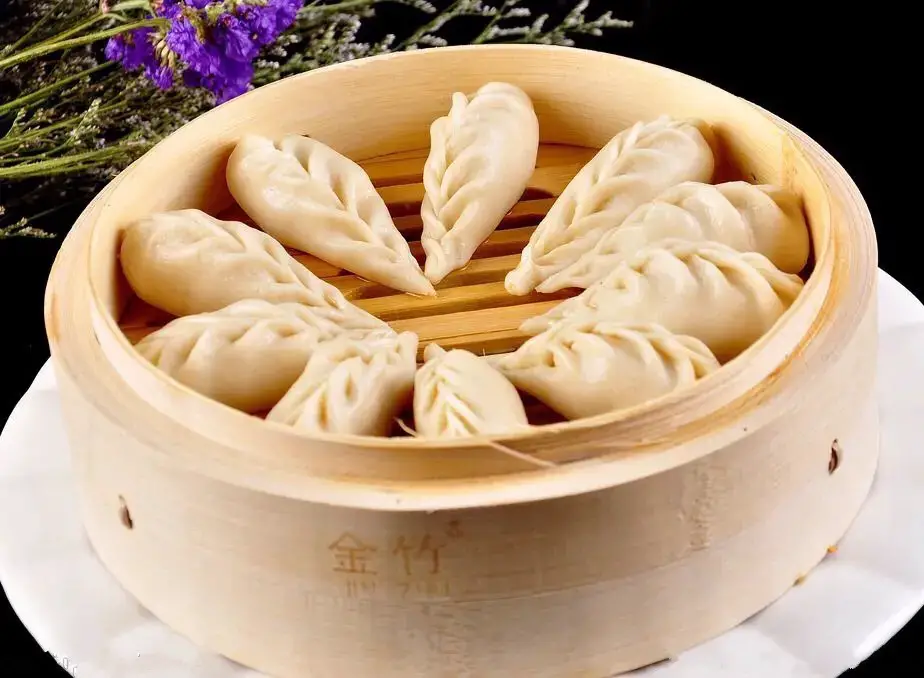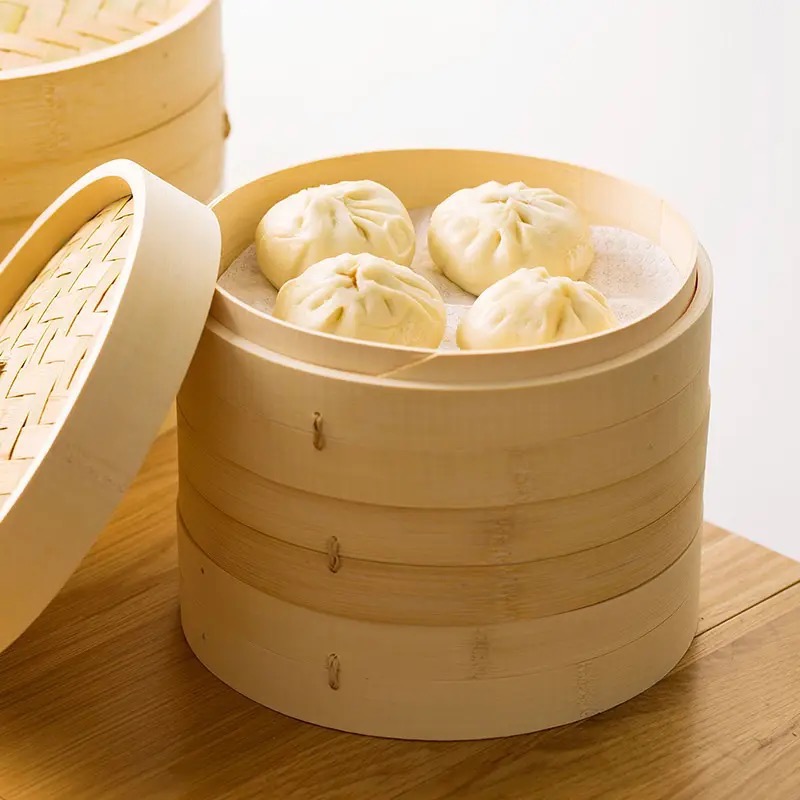Besides their minimal and appealing aesthetics, bamboo steamers are considered one of the healthiest ways to prepare many meals, including dumplings, buns, fish fillets, chicken, vegetables, and sticky rice. Bamboo steamers are one of the earliest methods of cooking and reheating food. So, what is a bamboo steamer? Where did they originate from? How do you use them? How do you clean and maintain them? What are the benefits of using a bamboo steamer? How are they made?
If you’ve never used or owned a bamboo steamer and would like to learn the answers to these questions and discover much more about this kitchen item, keep reading.
What is a bamboo steamer?

A bamboo steamer is a cookware made from bamboo that contains two or more stackable woven trays and a snugly fitting lid assembled when preparing meals. The bamboo trays have openings on the bottom to allow steam to pass through all the trays when steaming.
The bamboo steamer is placed in a pot or a wok, usually filled about an inch with boiling water to produce steam to cook whatever is in the trays. This steamer has a base, usually the only part that touches the hot water, so the steamed meal doesn’t touch the water. The meal inside the steamer is then cooked by the hot moist hair from the hot water.
Bamboo steamers usually prepare small batches of various meals, typically Chinese cuisine, mostly vegetables, fish, dumplings, and rice.
Bamboo steamer history and origin
Bamboo steamers are known to have originated around 5000 years ago in Southern China during the Han Dynasty, approximately between 206 BC and 220AD. Out of the 1200 bamboo steamers species, 400 have been discovered in China. During these ancient years, China had an abundance of bamboo. According to history, the Chinese people made good use of these resources and made a wide variety of items, bamboo steamers being one of the most popular items.
According to historians, the Chinese invented the bamboo steamer out of needing an efficient, lighter, better, and faster method of steaming. This need was promoted by the increasing population, growing commercial activities, and increased immigration into China. Bamboo steamers provided an excellent, sustainable solution.
Why use a bamboo steamer?

There are numerous benefits of using a bamboo steamer, and one of the advantages is that whatever you prepare with the bamboo steamer won’t be soggy. It’s common knowledge that due to condensation, steam usually settles on stainless steel or glass lids as water droplets, which then drip back into the meal being prepared, causing it to be soggy. This is particularly annoying, especially when preparing delicate meals like fish. Thankfully, bamboo steamers absorb the excess water preventing your food from becoming soggy.
Another reason to use a bamboo steamer is that they are lightweight. Unlike steel steamers, bamboo steamers are light since they are made from woven bamboo.
Also, because you can stack several trays of bamboo in your bamboo steamer basket, you can prepare several dishes at once, making this an efficient method of food preparation.
Additionally, bamboo steamers are affordable, unlike glass and stainless steel steamers. With $20-$50, you can get a decent-sized good-quality bamboo steamer. You get an excellent quality bamboo steamer for an even more affordable price if you source from any Asian marketplace or supermarket.
Another reason you should use a bamboo steamer is that it’s a quick cooking method. Steam has very high temperatures that can cook a meal in minutes. With the bamboo lid on top, steam can circulate properly within the steamer, evenly cooking whatever is inside.
Bamboo steamers are also considered one of the healthiest ways to cook meals. For instance, steaming doesn’t cook away all the nutrients in vegetables; therefore, if you’re preparing vegetables with a bamboo steamer, you’re guaranteed that they have retained most of their nutrients. Also, if you’re cooking fatty meals, the openings at the bottom of the bamboo steamer allow excess fat to drip into the hot water, leaving you with a lighter meal.
Bamboo steamers allow you to have excellent quality and appealing meals as the food retains its color, texture, flavor, and shape as it is a gentler method of food preparation.
How to use bamboo steamer baskets
How to use the bamboo steamer for dumplings

Start lining your bamboo steamer with lettuce leaves, parchment paper, cheesecloth, or Napa cabbage leaves to steam dumplings. This will keep your dumplings from sticking to the bottom of the steamer. Then, poke holes in whatever you’ve used to line the steamer, allowing the steam to pass through smoothly while cooking.
Proceed to place the dumplings into the steamer, leaving a bit of space between them, and cover the bamboo steamer with its lid.
The next step is to fill about an inch of a pan or wok with water, place the pan over medium heat and bring it to a boil, and place the steamer in the pan, ensuring the water doesn’t pass the steamer’s base to prevent the dumplings from touching the water. When you place the steamer in the pan, reduce the heat to low and let the water simmer, releasing steam into the bamboo steamer. Steam the dumplings for about ten minutes, keeping an eye on the water level during this period. Add hot water if the water level goes down before the dumplings are cooked. Your bamboo steamer should fit nicely into the pan or wok and shouldn’t be bigger.
How to use the bamboo steamer for sticky rice
To steam sticky rice with a bamboo steamer, fill about an inch of a pan or wok with water and place it over medium heat to boil. Ensure the water doesn’t touch the bamboo steamer’s underside to avoid it getting into the rice.
Place the washed, soaked, and rinsed rice into the bamboo steamer and give it a nice jiggle to ensure it’s leveled nicely, then place the bamboo steamer into the pan with boiling water. Cover the steamer with its lid bamboo and let the rice steam for ten minutes.
After ten minutes, remove the lid, grab the steamer by its ears and jiggle it a bit to resit the rice, then place it back into the boiling water to steam for another five minutes. If the water in the pan or wok lessens, add hot water, ensuring it doesn’t pass the base of the steamer. Remove the rice and serve.
How to use the bamboo steamer for bao buns

To prepare bao buns in a bamboo steamer, fill about an inch of a pan or wok (that the steamer can snugly fit in) with water and place it over medium heat. Proceed to line the bamboo steamer with parchment paper, poke holes in the paper, and spread out the buns inside the steamer. Leave a bit of room around each bun because they expand when steamed. Cover the bamboo steamer with its lid.
Place the bamboo steamer with bao buns into the pan with boiling water ensuring the water only touches the base of the steamer, and turn the heat low. Let the simmering water steam the bao buns inside the bamboo steamer for 5-6 minutes. Ensure you don’t remove the lid as the buns are cooking since it’s the steam trapped inside that’s doing the cooking. After 5-6 minutes, carefully take the bamboo steamer out of the pan and turn off the heat. Remove the lid carefully and serve the bun.
How to make a bamboo steamer
Bamboo steamers are made with bamboo, as mentioned earlier. The bamboo is harvested and prepared by removing the skin, smoothening, and splitting it into strips. The base of the bamboo steamer is prepared by being soaked in water, curved into a perfect circle, and hammered with nails to secure it. The bamboo strips are soaked in water to become pliable and then woven. The bamboo trays are also made from woven bamboo strips. Weaving the strips allows for small spaces where steam passes through during the cooking process.
Depending on the size of the bamboo steamer, it takes the artisan anywhere from fifteen minutes to make a bamboo steamer; this is without factoring in the bamboo preparation process.
When to clean a bamboo steamer
A bamboo steamer should be cleaned after every use to remove any food remains. There are several ways you can clean a bamboo steamer, but the easiest way is to soak it in hot soapy water for about fifteen minutes and then scrub it gently but firmly with a soft brush ensuring you remove all the food stuck on it.
After scrubbing the bamboo steamer and its lid, rinse them in hot water. Let the steamer and the lid air dry on a drying rack or the countertop entirely before storage. Ensure the dripping water from the steamer, and its lid is not sitting at the bottom of the steamer. Storing your bamboo steamer without letting it dry properly will cause mold.
It’s also a good idea to wash the bamboo steamer with hot water before using it to remove any dust.
How long does a bamboo steamer last?
A bamboo steamer can last anywhere from five years if cleaned and cared for properly. These steamers are made of bamboo, which is a very durable material. To ensure your bamboo steamer serves you for years, always wash it properly and, most importantly, let it air dry completely to prevent mold.
Conclusion
Bamboo steamers are an efficient, environmental-friendly, sustainable, affordable, and healthy way of steaming meals. Because of this, bamboo steamers have been famous for decades, not only in the Asian countries where they originated but also throughout the globe. With diligent care, this cookware can serve you for many years, saving you time and energy during your cooking process.